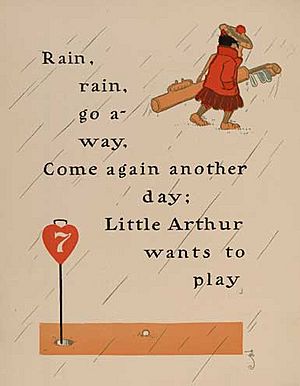Rain Rain Go Away facts for kids
Quick facts for kids ""Rain Rain Go Away"" |
|
|---|---|

Lia Wallace Denslow's illustrations for a variant of Rain Rain Go Away, from a 1901 edition of Mother Goose
|
|
| Nursery rhyme | |
| Published | 17th century or earlier |
"Rain Rain Go Away" is a very old and popular English language nursery rhyme. Many children learn this rhyme when they are young. It's often sung or said when it's raining, hoping the rain will stop so they can go outside and play! This rhyme is so well-known that it has a special number in the Roud Folk Song Index, which helps keep track of traditional songs and rhymes.
Rhyme's Words
There are a few different ways people say this rhyming couplet (which means two lines that rhyme). The most common version you hear today is:
- Rain rain go away,
- Come again another day.
Where the Rhyme Began
Similar rhymes can be found in many cultures, even as far back as ancient Greece. The modern English version of "Rain Rain Go Away" has been around for a long time, at least since the 1600s.
In the 17th century, a writer named James Howell wrote down a similar saying in his collection of proverbs. It went like this:
- Rain rain go to Spain: fair weather come again.
Later, in 1687, another writer named John Aubrey noted a version that sounds very much like the one we know today. He said "little children" used it to "charm away the Rain..." This version was:
- Rain Rain go away,
- Come again on Saturday.
Over the years, many different endings have been recorded for the rhyme. Some of these include:
- "Midsummer day"
- "washing day"
- "Christmas Day"
- "Martha's wedding day"
In the mid-1800s, a collector of rhymes named James Orchard Halliwell wrote down this version:
- Rain, rain, go away
- Come again another day
- Little Arthur wants to play.
Towards the end of the 1800s, another book showed these words:
- Rain, Rain,
- Go away;
- Come again,
- April day;
- Little Johnny wants to play.

